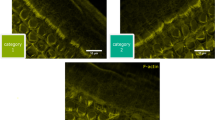Abstract
The number of surviving spiral ganglion neurons (SGNs) is important for the function of cochlear implants. Electrical stimulation has been discussed controversially regarding its protective effects on SGNs both in vivo and in vitro. The aim of this study was to develop a device for electrical stimulation of cultured SGNs. The developed device was first evaluated with cultivated fibroblasts at voltages from 10 to 60 V using biphasic rectangular pulses (pulse width: 10 ms, frequency: 50 Hz, stimulus burst: 1 s, interburst interval: 19 s). Possible toxic effects of 48 h patterned electrical stimulation were evaluated by propidium-iodide flow cytometry of the harvested fibroblasts. Second, the effects of 48-h electrical stimulation at voltages of 6 and 30 V on survival of cultivated SGNs were investigated as a single treatment and in the presence of brain-derived neurotrophic factor (BDNF, 100 ngml) in the culture medium. The results demonstrated constant pH and temperature behavior during electrical stimulation. Furthermore, no toxic effects on fibroblasts up to 40 V were found. The electrical stimulation of cultured neurons did not alter the survival rate compared to unstimulated control conditions. While BDNF application alone showed a significant effect on SGN survival, combination with electrical stimulation resulted in a not significantly increased cell survival. As a limitation of the study, the sensitivity of the described experimental setup appears to be low and only one stimulation pattern has been tested. Thus, experiments using different patterns of electrical stimulation and a more sensitive cultivation setup have to be carried out to fully investigate the effects of electrical stimulation on cultured SGNs. In this context, the developed device can be of help as it provides controlled and reproducible electrical stimulation conditions.





Similar content being viewed by others
References
Dodson HC, Mohuiddin A (2000) Response of spiral ganglion neurones to cochlear hair cell destruction in the guinea pig. J Neurocytol 29:525–537
Gantz BJ, Woodworth GG, Knutson JF, Abbas PJ, Tyler RS (1993) Multivariate predictors of audiological success with multichannel cochlear implants. Ann Otol Rhinol Laryngol 102:909–916
Shinohara T, Bredberg G, Ulfendahl M, Pyykko I, Olivius NP, Kaksonen R, Lindstrom B, Altschuler R, Miller JM (2002) Neurotrophic factor intervention restores auditory function in deafened animals. Proc Natl Acad Sci USA 99:1657–1660
Zheng JL, Stewart RR, Gao WQ (1995) Neurotrophin-4/5 enhances survival of cultured spiral ganglion neurons and protects them from cisplatin neurotoxicity. J Neurosci 15:5079–5087
Hartshorn DO, Miller JM, Altschuler RA (1991) Protective effect of electrical stimulation in the deafened guinea pig cochlea. Otolaryngol Head Neck Surg 104:311–319
Lousteau RJ (1987) Increased spiral ganglion cell survival in electrically stimulated, deafened guinea pig cochleae. Laryngoscope 97:836–842
Ni D, Shepherd RK, Seldon HL, Xu SA, Clark GM, Millard RE (1992) Cochlear pathology following chronic electrical stimulation of the auditory nerve. I: normal hearing kittens. Hear Res 62:63–81
Shepherd RK, Matsushima J, Martin RL, Clark GM (1994) Cochlear pathology following chronic electrical stimulation of the auditory nerve: II. Deafened kittens. Hear Res 81:150–166
Li L, Parkins CW, Webster DB (1999) Does electrical stimulation of deaf cochleae prevent spiral ganglion degeneration? Hear Res 133:27–39
Hegarty JL, Kay AR, Green SH (1997) Trophic support of cultured spiral ganglion neurons by depolarization exceeds and is additive with that by neurotrophins or cAMP and requires elevation of [Ca2+]i within a set range. J Neurosci 17:1959–1970
Miller JM, Miller AL, Yamagata T, Bredberg G, Altschuler RA (2002) Protection and regrowth of the auditory nerve after deafness: neurotrophins, antioxidants and depolarization are effective in vivo. Audiol Neurootol 7:175–179
Balkowiec A, Katz DM (2000) Activity-dependent release of endogenous brain-derived neurotrophic factor from primary sensory neurons detected by ELISA in situ. J Neurosci 20:7417–7423
Shepherd RK, Coco A, Epp SB, Crook JM (2005) Chronic depolarization enhances the trophic effects of brain-derived neurotrophic factor in rescuing auditory neurons following a sensorineural hearing loss. J Comp Neurol 486:145–158
Lefebvre PP, Van De Water TR, Weber T, Rogister B, Moonen G (1991) Growth factor interactions in cultures of dissociated adult acoustic ganglia: neuronotrophic effects. Brain Res 567:306–312
Aletsee C, Volter C, Brors D, Ryan AF, Dazert S (2000) Die Wirkung von Fibroblastenwachstumsfaktor-1 (FGF-1) auf Spiralganglienzellen der Säugetiercochlea. In: HNO, vol 48, pp 457–461
Wefstaedt P, Scheper V, Lenarz T, Stöver T (2005) Brain-derived neurotrophic factor/glial cell line-derived neurotrophic factor survival effects on auditory neurons are not limited by dexamethasone. NeuroReport 16:2011–2014
Brevet A, Pinto E, Peacock J, Stockdale FE (1976) Myosin synthesis increased by electrical stimulation of skeletal muscle cell cultures. Science 193:1152–1154
Campenot RB (1977) Local control of neurite development by nerve growth factor. Proc Natl Acad Sci USA 74:4516–4519
Nelson PG, Yu C, Fields RD, Neale EA (1989) Synaptic connections in vitro: modulation of number and efficacy by electrical activity. Science 244:585–587
Rejali D, Lee VA, Abrashkin KA, Humayun N, Swiderski DL, Raphael Y (2007) Cochlear implants and ex vivo BDNF gene therapy protect spiral ganglion neurons. Hear Res 228:180–187
McLeod KJ, Lee RC, Ehrlich HP (1987) Frequency dependence of electric field modulation of fibroblast protein synthesis. Science 236:1465–1469
Kanzaki S, Stover T, Kawamoto K, Prieskorn DM, Altschuler RA, Miller JM, Raphael Y (2002) Glial cell line-derived neurotrophic factor and chronic electrical stimulation prevent VIII cranial nerve degeneration following denervation. J Comp Neurol 454:350–360
Conflict of interest
The authors declare that they have no competing interests.
Author information
Authors and Affiliations
Corresponding authors
Rights and permissions
About this article
Cite this article
Wefstaedt, P., Paasche, G., Parker, J. et al. A device for patterned electrical stimulation of cultivated cells: preliminary tests with rat auditory neurons. Eur Arch Otorhinolaryngol 270, 841–848 (2013). https://doi.org/10.1007/s00405-012-2030-7
Received:
Accepted:
Published:
Issue Date:
DOI: https://doi.org/10.1007/s00405-012-2030-7




